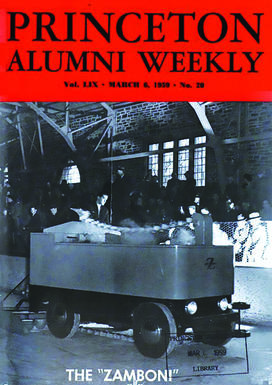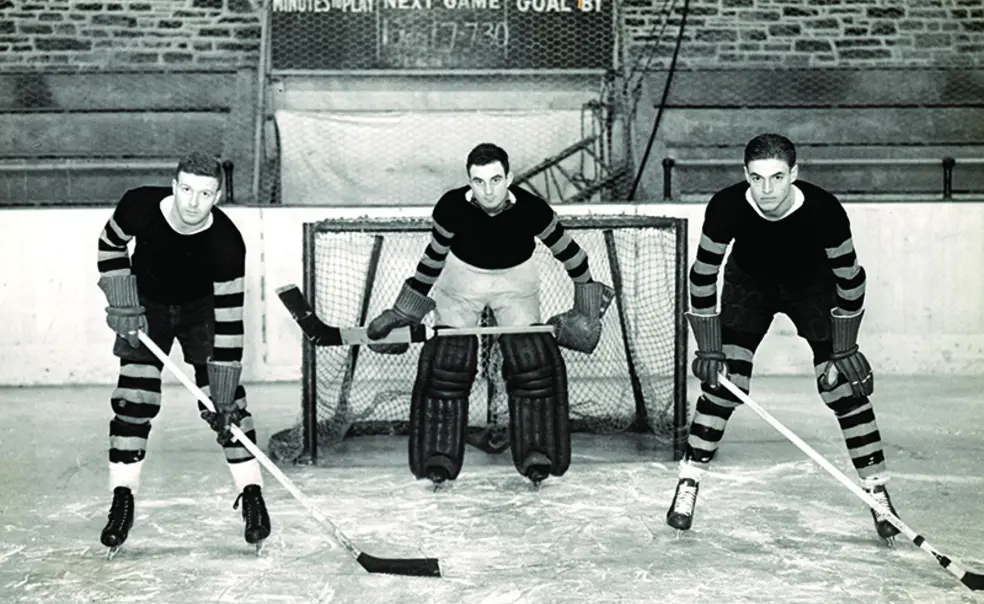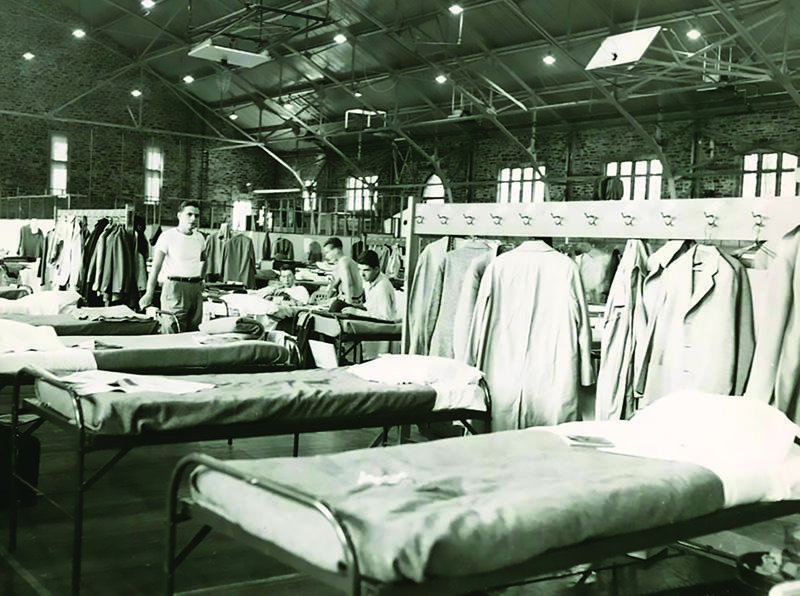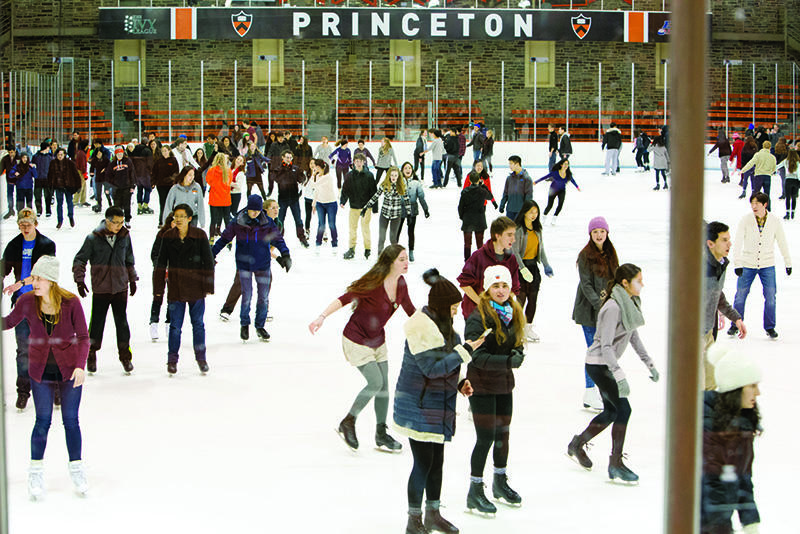For 100 Years Baker Rink Has Been Hockey Heaven
Historic rink maintains a unique place in the game a century after its opening
Cara Morey, head coach of the women’s hockey team, often talks with recruits who’ve never seen the tiger-adorned wooden doors, stone walls, and exposed steel rafters of Baker Rink, the historic home of Princeton hockey.
“I describe it as the most beautiful rink in the country,” says Morey, who starred at Brown in the late 1990s and early 2000s. “When I was a player in college, Princeton was my favorite road trip.”
When its 2,100 seats are filled for games against the Tigers’ rivals or the program’s annual “Blackout Baker” night (when fans dress in black and students receive free T-shirts), it reminds Morey of junior hockey rinks in her native Canada, where whole towns come out to see their teams play.
The building may look like it belongs to an earlier era, but Baker’s appeal goes beyond mere nostalgia. With each Princeton goal, LED lights over the ice flash orange and the PA system blares the soul-thumping drum and trumpet intro of Blasterjaxx’s “Narco.” Fight songs played by pep bands in the east-end balcony echo through the building. On the lower level, just six rows of seats surround the playing surface, so no spectator is more than about 20 feet from the ice.
“The atmosphere is terrific,” says Ron Fogarty, head coach of the men’s team. “Every viewpoint is right on top of the action.”
As Princeton’s first and only on-campus hockey rink, Baker has been central to the sport — and generations of players — since its inaugural game in January 1923. This month, the men’s and women’s teams will celebrate its centennial with a pair of doubleheaders against Harvard and Dartmouth Jan. 6 and 7. Gen. Mark Milley ’80, the chairman of the Joint Chiefs of Staff and a former Princeton defenseman, is slated to drop the ceremonial first puck for the Saturday night men’s game. (For more information about #Hobey100 events, see goprincetontigers.com.)
The rink’s namesake, Hobey Baker 1914, was Princeton’s first hockey star, earning a reputation as “the one you could not take your eyes off,” according to Tim Rappleye, author of the 2018 biography Hobey Baker: Upon Further Review. The speedy, blond-haired Baker was hard to miss, streaking down the ice on end-to-end rushes. But without a rink on campus, his Princeton teams played their home games in Manhattan.
After graduation and a celebrated amateur hockey career, Baker became a fighter pilot in Europe during World War I. He survived his wartime service but tragically died on a test flight in France in December 1918, six weeks after the armistice was signed.
In December 1921, Princeton alumni publicly raised the idea of building an ice rink in his honor in PAW and The Daily Princetonian. More than 1,500 of Baker’s friends and admirers supported the cause, Rappleye says, including scores of rivals from Harvard and Yale. Within 12 months, the structure was completed and the ice-making equipment installed.
The building opened with a game between the Princeton varsity and Baker’s former teammates from the St. Nicholas Hockey Club. Today, it is the country’s second-oldest college rink still in use, trailing only Northeastern’s Matthews Arena, formerly Boston Arena, where Baker’s Tigers faced off against rival Harvard.
When a fire destroyed the University Gym in 1944, Baker’s ice gave way to floorboards and the rink served as a gym, auditorium, and even a temporary barracks-style dormitory. More recently, it has been home to student “skate nights,” sponsored by the Office of the Dean of Undergraduate Students. And twice a week, it hosts lunchtime hockey games for a group of faculty, staff, students, and community members, ranging in age from 20 to 70-plus.
Donning jerseys that read “Princeton Baker Noontime Hockey,” with the “Baker” fashioned into the shape of a biplane, they split into two squads (orange and black) and scrimmage for about an hour. “It’s where I learned to play,” Aubrey Huston k’44, a retired editor of The Princeton Packet who first skated at Baker in the late 1950s, told PAW after a noontime game in early December. “Some of us are just not smart enough to give up.”
Baker’s ice has played host to nearly two dozen future NHL and NWHL/PHF players from Princeton, including Jeff Halpern ’99, George Parros ’03, and Kelsey Koelzer ’17, along with visiting stars such as Hall-of-Fame players Ken Dryden (Cornell), Martin St. Louis (Vermont), Cammi Granato (Providence), and Angela Ruggiero (Harvard). Two Tigers from the women’s team won gold for Canada at the 2022 Olympics in Beijing, including one who is still playing for Princeton, Sarah Fillier ’24.

But not every team that captured the hearts of Tigers fans had a superstar player or a stellar record. Take, for example, the men’s team of 1970-71, which finished its season with one win and 22 losses.
Goalie E.M. Swift ’73, who later wrote about that season for Sports Illustrated — his first byline in a 32-year career at the magazine — says interest in the team grew as the losses piled up: “We were very much like the old Mets.”
On the eve of the season’s finale, students arranged a pep rally at Blair Arch, and the following night, 2,400 spectators, including President Bob Goheen ’40 *48, showed up to see the Tigers face Dartmouth. Princeton lost, 4-3, but received a standing ovation afterward.
Mike Moore ’08 played in front of full-house crowds with happier results: He captained the men’s team that won eight of its last nine home games and captured the Ivy League and ECAC championships in 2007-08.
Many of Moore’s favorite Baker memories are not of game nights, though. His mind is drawn instead to moments of bonding, like the late-night, players-only practice he helped to plan before the start of his senior year.
“Your team is your second family, and Baker Rink is your home,” Moore says. “You’re there every day of the year, even before the season starts and after the season ends.”
Andrea Kilbourne-Hill ’02, who won a silver medal with the U.S. women’s team at the 2002 Salt Lake City Olympics, says that visiting the rink is like returning to your childhood home. As an undergrad, she blew off steam during exams by playing pickup games. “Stepping on the ice from the tunnel is always a great feeling,” she says.
Last year, Kilbourne-Hill’s children had a chance to skate at Baker, playing with current students at a Reunions event. It made an impression: When she asked the kids to help name the family’s new goldendoodle puppy, they chose “Hobey.”
















2 Responses
Marion Huston Lisko k’44
2 Years AgoSo Much More Than Hockey
Baker Rink is so much more than hockey. I was learning to figure skate, and the Princeton Skating Club was probably the second most important group to that rink for my formative years. Every Sunday my two best buddies and I would spend all day at that rink. We would alternate who brought the PB & J’s, the money for vending machine hot chocolate, and the cigarettes for our one hour of time off between 8 am to 4:30 that afternoon. We had a blast sitting in the balcony being teenagers off the ice!
But, since my brother was a hockey player, we frequented the weekend games. Back in those days everyone pretty much knew everybody from town, and we would enjoy another place to connect. As I got older it became a source of where to meet up, and possibly meet someone new — like a university boy. I even got to take figure skating lessons from the campus’s new teacher, Tisha Baird. What a thrill I got from being coached by such a famous skater!
I wish I could have been there for the big celebration but my brother was sure to represent the Huston skating team. I made him make sure to get a photo with the Stanley Cup to send me, which I will treasure.
Nothing will I treasure more, though, than my many, many years of skating at Baker Rink passing and failing USFSA tests, participating in the Ice Carnivals, and being a kid growing into a teen with my friends.
Kai L. Chan *08
3 Years AgoBaker Rink More Than Just a Hockey Heaven
It was great to read about the role that Baker Rink has played at Princeton over the years (Sports, January issue). I was part of the Noontime Hockey group when I was a student back in the early 2000s. I also played intramural hockey at Baker during my time. One year the team I organized (named “A Bunch of Grad Students”) won the championship, surprising our undergraduate opponents who thought that they would walk over us — we were a team of mostly Canadians. When I went back several years ago for Reunions, I made it a point to take my skates with me so that I could get back on the ice.
The article did, however, forget to mention another notable activity at Baker Rink: broomball. Not sure of its status now, but back in my time it was the most popular intramural sport on campus, with perhaps two dozen teams registered. It was played in sneakers but on the ice, and with a “broom” and a large soft ball. The ice was a great equalizer, as athletic and non-sporty people would find themselves equally handicapped slipping, sliding, and falling on the ice.